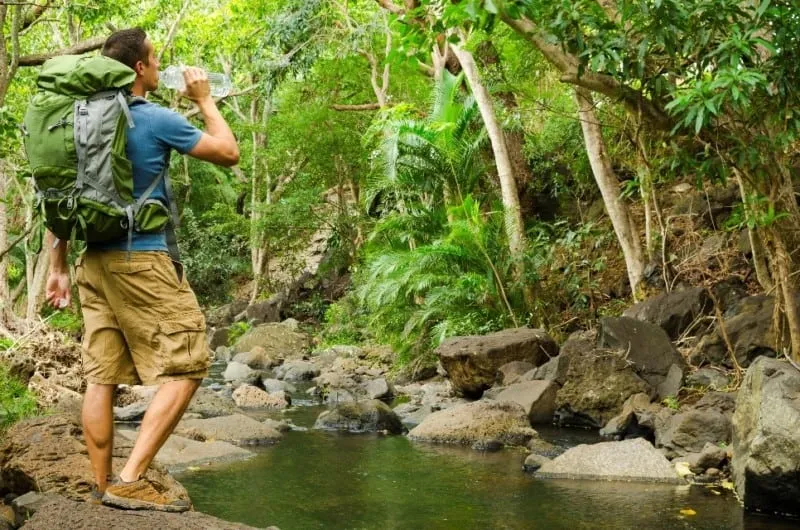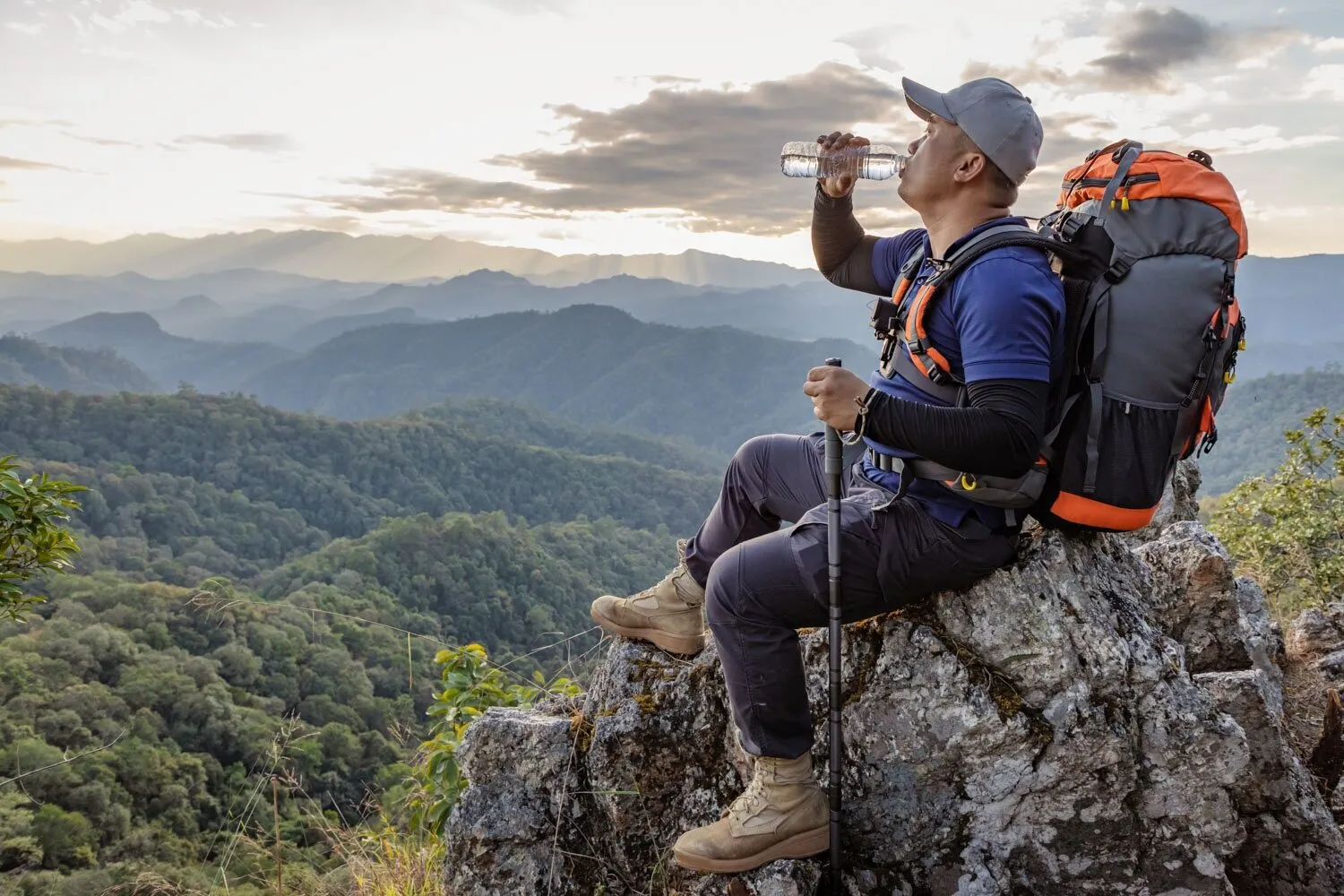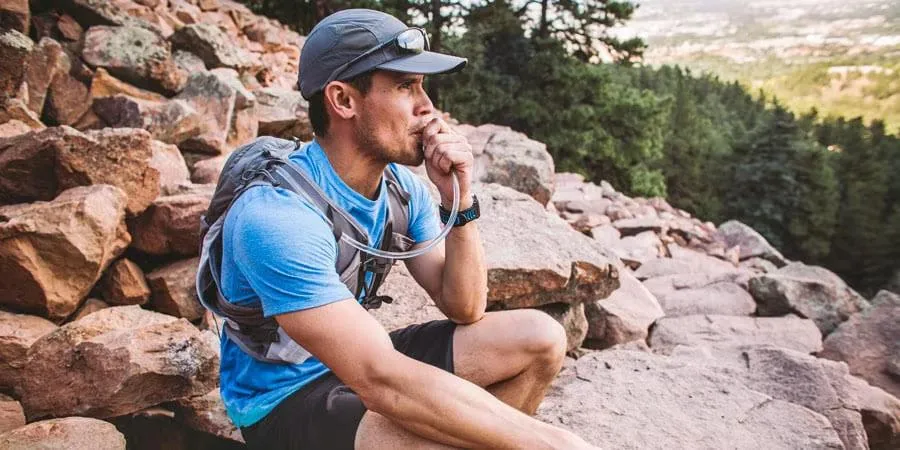As an experienced hiker who's traversed trails from the desert Southwest to the Rocky Mountains, I've learned that understanding how much water per hike can make the difference between an enjoyable adventure and a dangerous situation. After years of testing different hydration strategies and studying the science behind proper trail hydration, I'm sharing everything you need to know to stay safely hydrated on your next hiking adventure. Visit NatureGuests.com for more expert hiking guides and outdoor adventure tips.
Understanding Hiking Hydration Basics
When I first started hiking fifteen years ago in Arizona's Sonoran Desert, I made the classic mistake of underestimating how much water per hike I actually needed. That near-dehydration experience on a 105°F summer day taught me that proper hydration isn't just about comfort—it's about survival. The human body loses water through multiple pathways during hiking: breathing, sweating, and normal metabolic processes. What many hikers don't realize is that even in cold weather, your body continues to lose significant amounts of water through respiration and increased metabolic demands.

The science behind hiking hydration reveals that your body is approximately 60% water, and even a 2% decrease in body water can significantly impact physical performance and cognitive function. During moderate hiking activity, you can lose between 1-3 liters of water per hour through sweat alone, depending on environmental conditions and individual factors. This is why understanding how much water per hike requires more than just following generic recommendations—it demands a personalized approach based on your specific circumstances.
From my experience leading group hikes in various climates, I've observed that dehydration symptoms often appear gradually and can be mistaken for normal hiking fatigue. Early signs include decreased energy, mild headaches, and reduced urination frequency. More serious symptoms progress to dizziness, nausea, and confusion—all potentially dangerous situations on remote trails. Conversely, overhydration (hyponatremia) can be equally dangerous, diluting essential electrolytes and causing cellular dysfunction. This balance is why calculating your precise water needs is crucial for safe hiking.
Calculating Your Water Needs
After testing various formulas across hundreds of hikes, I've found that determining how much water per hike requires understanding both the basic calculation methods and their practical applications. The most widely accepted baseline formula is one liter of water for every two hours of hiking under moderate conditions. However, this is just a starting point—real-world application requires adjusting for multiple variables that I'll detail throughout this section.
The Standard Water Calculation Formula
Base Formula: 1 liter per 2 hours of hiking
Alternative Method: 0.5 liters per hour of moderate activity
Desert/High Heat: 1 liter per hour or more
To calculate hiking time accurately, I use Naismith's Rule, which allows one hour for every three miles of distance plus an additional hour for every 2,000 feet of elevation gain. For example, a 6-mile hike with 1,000 feet of elevation gain would take approximately 2.5 hours (2 hours for distance + 0.5 hours for elevation). Using the standard formula, this hike would require 1.25 liters of water under moderate conditions. However, I always recommend carrying at least 50% more than your calculated needs as a safety margin.

During my extensive hiking experiences across different terrains, I've developed a more nuanced approach to calculating how much water per hike. In desert conditions like those I regularly encounter in Arizona and Utah, I plan for 1 liter per hour as a minimum, often increasing to 1.5 liters per hour during summer months. In contrast, for winter hiking in cooler climates, I might reduce this to 0.5 liters per hour while still monitoring hydration status carefully. The key is understanding that these calculations provide a foundation, but personal experience and careful monitoring should always guide your final decisions.
One crucial aspect many hikers overlook is accounting for water needed beyond just drinking. If you're planning to cook meals, clean dishes, or treat injuries, you'll need additional water beyond your hydration calculations. I typically add 0.5-1 liter for cooking and general camp use on overnight trips. For day hikes, consider whether you'll need water for first aid situations or helping other hikers who may have underestimated their needs. For more detailed information about trail safety and hydration strategies, check out our comprehensive guide on avoiding dehydration while hiking.
Factors Affecting Water Consumption
Understanding the variables that influence how much water per hike you'll need has been crucial to my hiking success over the years. Temperature stands as the most obvious factor, but I've learned that humidity, altitude, terrain difficulty, and personal factors play equally important roles. During a memorable summer hike in Death Valley, where temperatures reached 115°F, I consumed over 8 liters of water in just 6 hours—nearly triple my normal consumption rate for similar duration hikes in moderate conditions.
Environmental Factors
Temperature affects water needs exponentially rather than linearly. While you might need 2 liters for a 4-hour hike in 70°F weather, the same hike in 90°F conditions could require 4-5 liters. Humidity compounds this effect significantly—high humidity prevents efficient cooling through sweat evaporation, forcing your body to produce more sweat for the same cooling effect. I've found that hiking in 85°F with 80% humidity can be more demanding than hiking in 95°F desert conditions with low humidity.
Altitude presents another critical factor that many hikers underestimate when calculating how much water per hike. Above 8,000 feet, your respiratory rate increases to compensate for lower oxygen levels, leading to greater water loss through breathing. Additionally, the body's thirst mechanism becomes less reliable at altitude, making conscious hydration efforts even more important. During my climbs in Colorado's high country, I've learned to increase my water consumption by approximately 25% for every 3,000 feet above sea level, especially during the first few days of acclimatization. Learn more about managing hydration at elevation in our detailed article about altitude and hydration tips.
Personal and Physical Factors
Individual physiology plays a massive role in determining water needs. Body size, fitness level, acclimatization status, and personal sweat rates vary dramatically between hikers. Larger individuals generally require more water due to greater surface area and metabolic demands. However, I've observed that fitness level can work both ways—fitter hikers may be more efficient and require less water for the same effort, but they may also push themselves harder and cover more challenging terrain, ultimately increasing their needs.
Acclimatization significantly impacts water requirements, particularly when transitioning between climates or elevations. During my move from sea-level Oregon to high-altitude Colorado, I noticed increased water needs for several weeks as my body adapted. Heat acclimatization typically takes 10-14 days, during which your sweat rate may be higher and less efficient. This is why determining how much water per hike requires considering not just current conditions, but your recent exposure to similar environments.
Gear and clothing choices also influence hydration needs. Heavy packs increase metabolic demands and heat production, while improper clothing can trap heat and increase sweat rates. Dark colors absorb more heat, synthetic materials may not breathe as well as natural fibers, and overdressing for conditions forces your body to work harder to maintain proper temperature. I've learned to adjust my water calculations based on expected pack weight, adding approximately 100ml per hour for every 10 pounds above my normal pack weight. For insights on optimizing your trail nutrition alongside hydration, explore our guide to safe trail snacking.
Best Methods for Carrying Water
After years of experimenting with different water carrying systems, I've learned that the method you choose for transporting water can significantly impact both your hiking experience and your ability to stay properly hydrated. The decision of how much water per hike to carry is closely linked to how efficiently you can transport and access that water throughout your journey. Each carrying method has distinct advantages and disadvantages that become apparent only through extensive field testing.
Hydration Bladders and Reservoirs
Hydration bladders have become my preferred system for carrying large volumes of water efficiently. The hands-free drinking capability encourages regular hydration, which is crucial for maintaining optimal performance on longer hikes. I typically use a 3-liter bladder for day hikes and have found that the even weight distribution across my back is far superior to carrying multiple water bottles. The convenience factor cannot be overstated—being able to drink without stopping or removing my pack has proven invaluable during technical sections or when maintaining group pace.

However, bladders do present challenges that affect how you plan how much water per hike to carry. Refilling from natural sources can be cumbersome, especially with narrow-mouth bladders, and it's difficult to monitor exactly how much water remains. I learned this lesson during a hot Arizona hike when I thought I had plenty of water remaining, only to find my bladder nearly empty with miles still to go. Winter hiking presents additional complications as drinking tubes can freeze, rendering the entire system unusable until thawed.
Traditional Water Bottles
Smart Water bottles have gained popularity among ultralight backpackers, and for good reason. They're incredibly lightweight, durable, and feature threads compatible with most water filters. I often carry two 1-liter Smart Water bottles for day hikes, which allows me to easily monitor consumption and provides backup if one bottle is damaged. The clear plastic makes it simple to see exactly how much water remains, helping with rationing decisions on longer hikes.
Insulated bottles like Nalgenes or Hydro Flasks offer temperature control benefits that can be crucial in extreme conditions. During summer desert hikes, cold water provides a psychological boost and helps with core temperature regulation. Conversely, hot beverages in insulated bottles can be lifesaving during winter conditions. However, the weight penalty is significant—an empty Nalgene weighs nearly four times more than a Smart Water bottle of equivalent capacity, which affects your overall water carrying strategy when determining how much water per hike.
Water purification is essential when refilling from natural sources, and I always carry backup purification methods regardless of my primary carrying system. Understanding different water purification methods can dramatically reduce the amount of water you need to carry by enabling safe refills from streams, lakes, and springs along your route.
Pre, During, and Post-Hike Hydration Strategies
Effective hydration management extends far beyond simply calculating how much water per hike to carry—it encompasses a comprehensive approach that begins hours before you hit the trail and continues well after your return. Through years of experimentation and occasional painful lessons, I've developed a systematic approach to hydration that has dramatically improved my hiking performance and safety margins.
Pre-Hike Hydration Protocol
Starting your hike properly hydrated is perhaps the most important factor in your overall hydration strategy. I begin increasing my water intake 24-48 hours before any significant hike, paying particular attention to urine color as a hydration indicator. The goal is to begin your hike with light yellow urine—clear urine may indicate overhydration and electrolyte dilution, while dark yellow suggests dehydration. Two hours before hitting the trail, I consume 16-20 ounces of water, which allows time for proper absorption while minimizing the need for frequent bathroom breaks during the early miles.
Electrolyte preloading has become an essential part of my pre-hike routine, especially for challenging hikes in hot conditions. I consume a balanced electrolyte drink 30-60 minutes before starting, which helps optimize cellular hydration and provides a buffer against early electrolyte losses. This strategy has been particularly effective during my desert hiking adventures, where sweat rates can exceed 2 liters per hour. Avoiding alcohol and excessive caffeine in the 12 hours before hiking is equally important, as both substances have diuretic effects that can compromise your starting hydration status.
During-Hike Hydration Management
Maintaining proper hydration during your hike requires consistent attention and cannot be left to thirst alone. Thirst is a late indicator of dehydration, and waiting until you feel thirsty means you're already behind on your hydration needs. I've developed a system of drinking 4-6 ounces every 15-20 minutes, regardless of thirst level, adjusting upward in hot or challenging conditions. This consistent intake pattern helps maintain stable blood volume and prevents the performance decrements associated with even mild dehydration.
Monitoring your hydration status throughout the hike is crucial for adjusting your water consumption rate. Urine color remains the most practical field indicator, but paying attention to other signs like energy levels, headache development, and reduced urination frequency can provide early warnings. During longer hikes, I make mental notes of my consumption rate versus remaining water supply, allowing for strategy adjustments if needed. This self-monitoring has prevented several potential dehydration incidents when conditions proved more demanding than anticipated.
Electrolyte replacement becomes critical during extended hiking periods, particularly when sweat rates are high. Plain water alone can dilute blood sodium levels, leading to hyponatremia—a potentially dangerous condition I've witnessed firsthand during group hikes. I add electrolyte supplements to one of my water bottles for any hike exceeding 2 hours, increasing the concentration for hot weather or high-intensity efforts. This strategy helps maintain proper sodium balance while supporting continued optimal hydration. For comprehensive information about how much water per hike you need in various conditions, bookmark this guide for future reference.
Post-Hike Recovery Hydration
Recovery hydration is often overlooked but plays a crucial role in overall hiking performance and enjoyment. The goal is to replace both fluid and electrolyte losses from your hike, preparing your body for the next adventure. I weigh myself before and after longer hikes to quantify fluid losses, aiming to drink 150% of the weight loss in fluids over the following hours. For example, if I lose 2 pounds during a hike (equivalent to approximately 1 liter of fluid), I'll consume 1.5 liters of fluids post-hike, including both water and electrolyte-containing beverages.
The timing and composition of post-hike hydration significantly impact recovery effectiveness. Consuming fluids gradually over 2-4 hours post-hike allows for better absorption and retention compared to rapid consumption. I typically start with an electrolyte drink to address sodium losses, followed by gradual water intake. Including some carbohydrates in post-hike beverages enhances both fluid absorption and glycogen restoration, supporting faster overall recovery. This systematic approach to recovery hydration has notably reduced my next-day fatigue levels and improved my ability to maintain hiking schedules during multi-day adventures.
Conclusion
Mastering the art and science of determining how much water per hike has been one of the most valuable skills I've developed in my hiking journey. From my early days of carrying too little water in Arizona's desert heat to learning the nuances of high-altitude hydration in Colorado's peaks, each experience has reinforced that proper hydration planning is both a safety imperative and a performance enhancer. The baseline formula of 1 liter per 2 hours provides a foundation, but true expertise comes from understanding how environmental factors, personal physiology, and hiking conditions interact to influence your unique needs.
Remember that hydration planning encompasses much more than simply calculating volumes—it includes choosing appropriate carrying systems, implementing pre- and post-hike hydration protocols, and maintaining awareness of your hydration status throughout your adventure. The investment in proper hydration equipment, from quality bladders to reliable filtration systems, pays dividends in comfort, safety, and hiking enjoyment. Most importantly, building experience through careful monitoring and adjustment of your hydration strategies will develop the intuitive understanding that keeps you safe and performing optimally on every trail.
As you continue developing your hiking skills, remember that proper hydration is just one component of comprehensive outdoor safety and enjoyment. Continue exploring our resources on trail safety, navigation, and wilderness skills to build your complete outdoor competency. The trails are calling, and with proper hydration knowledge, you're equipped to answer that call safely and confidently on every adventure that lies ahead.
Ready to Hit the Trails Safely?
Apply these hydration strategies on your next hiking adventure and experience the difference proper preparation makes. Your body—and your hiking partners—will thank you for the extra effort invested in staying properly hydrated.
Happy trails, and stay hydrated!


